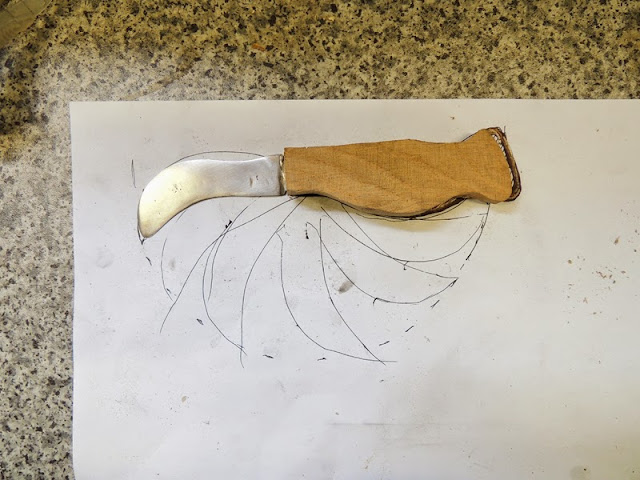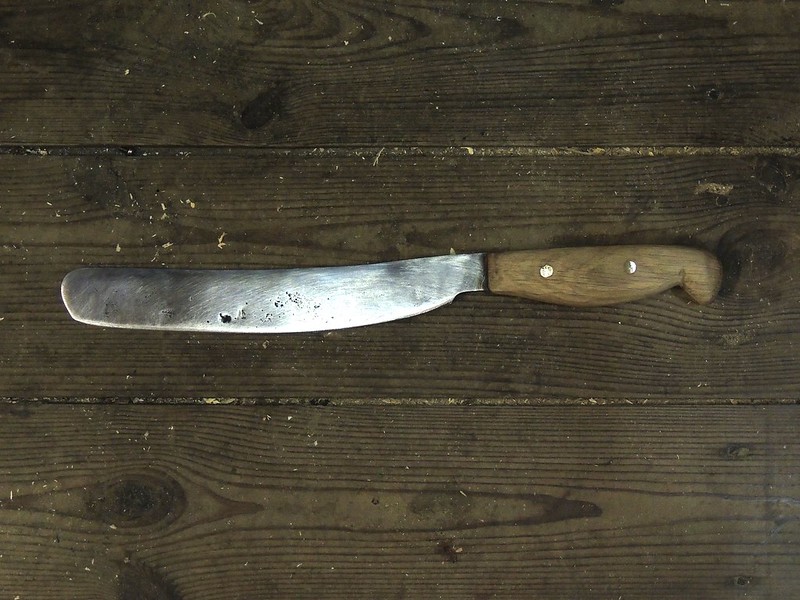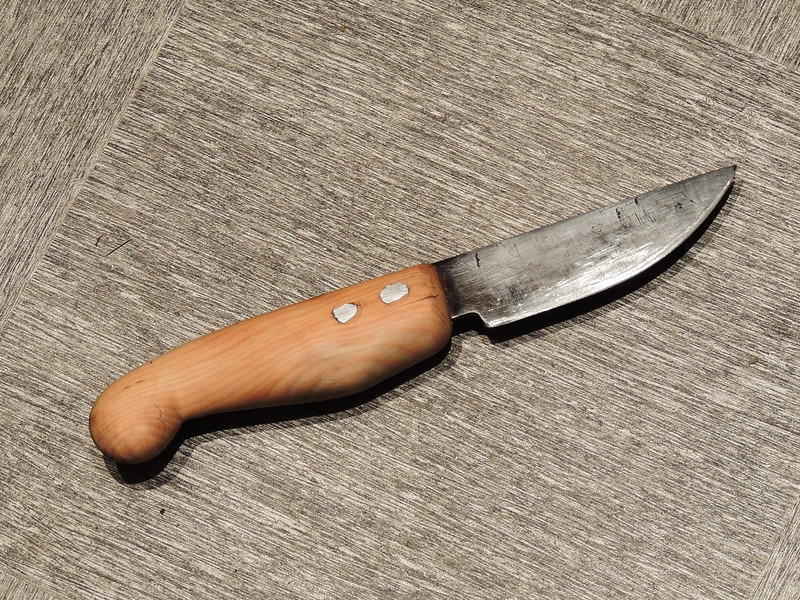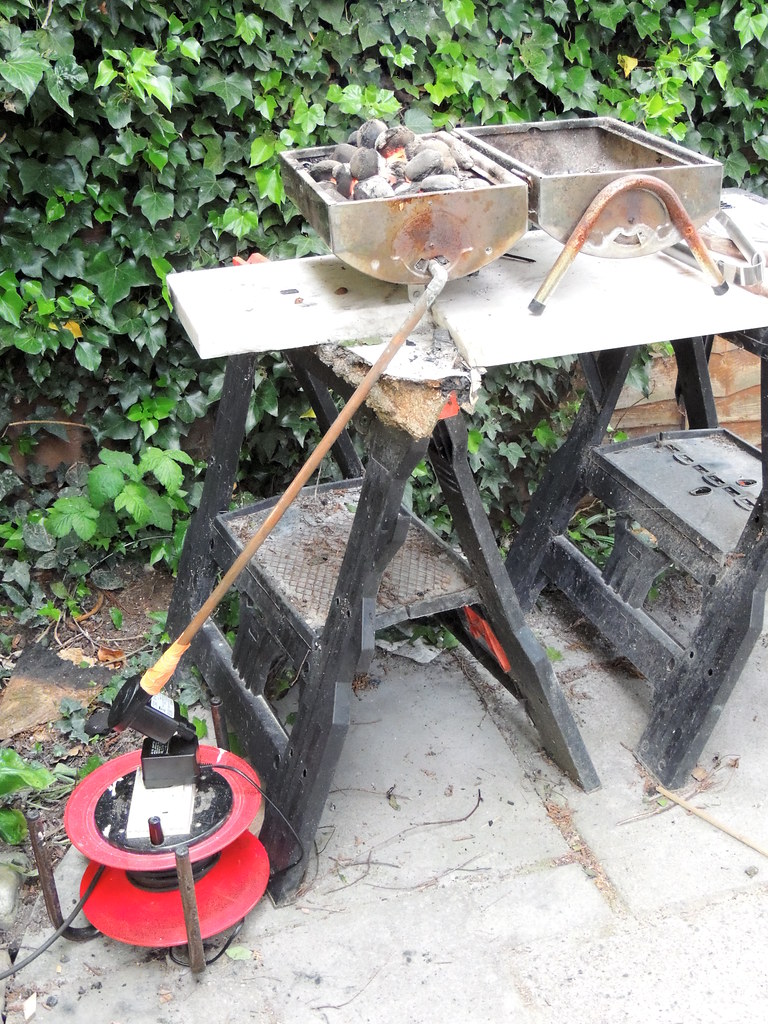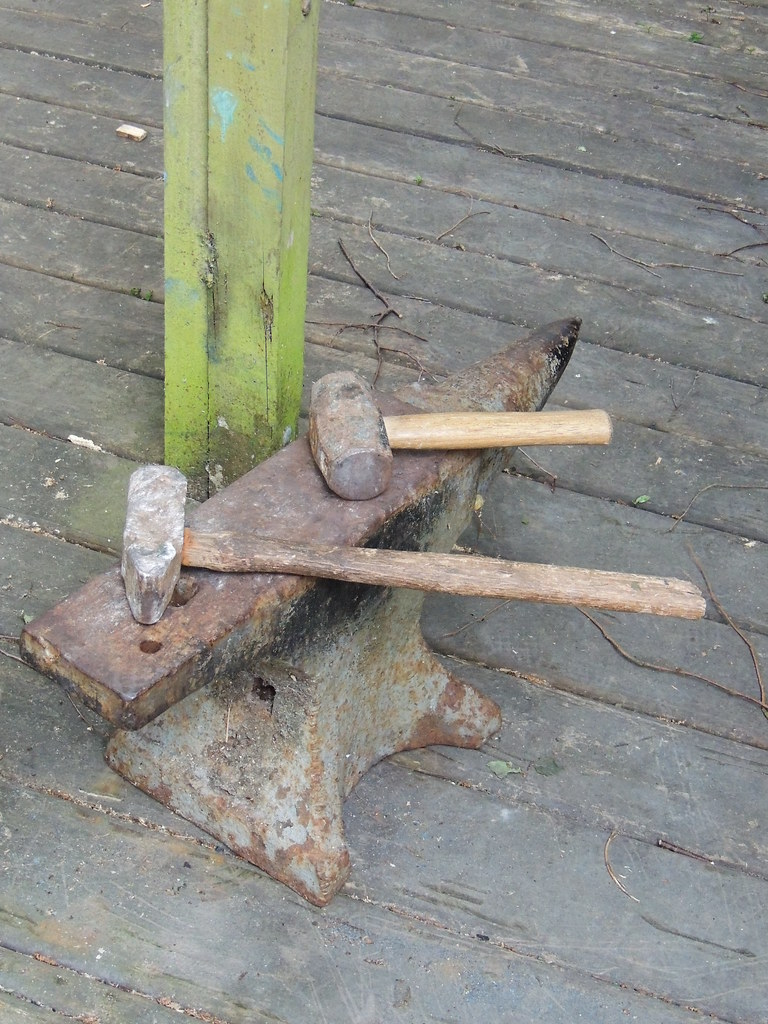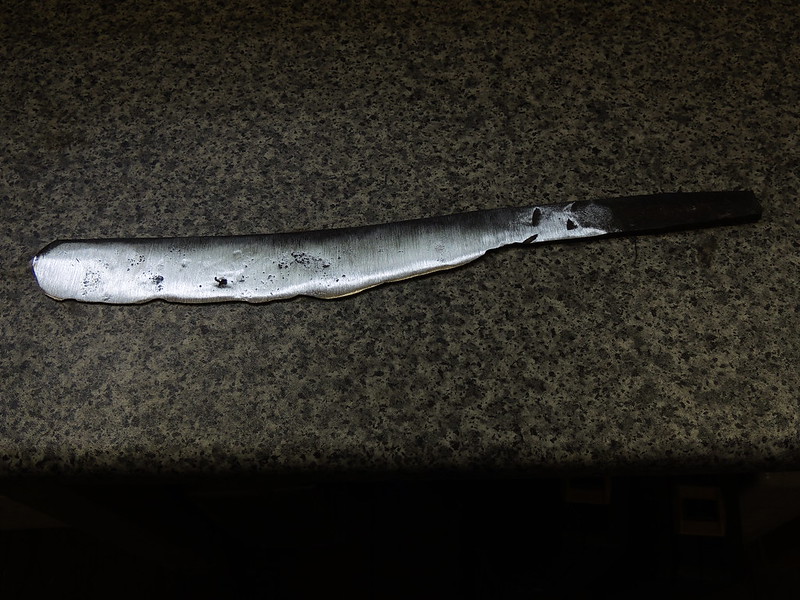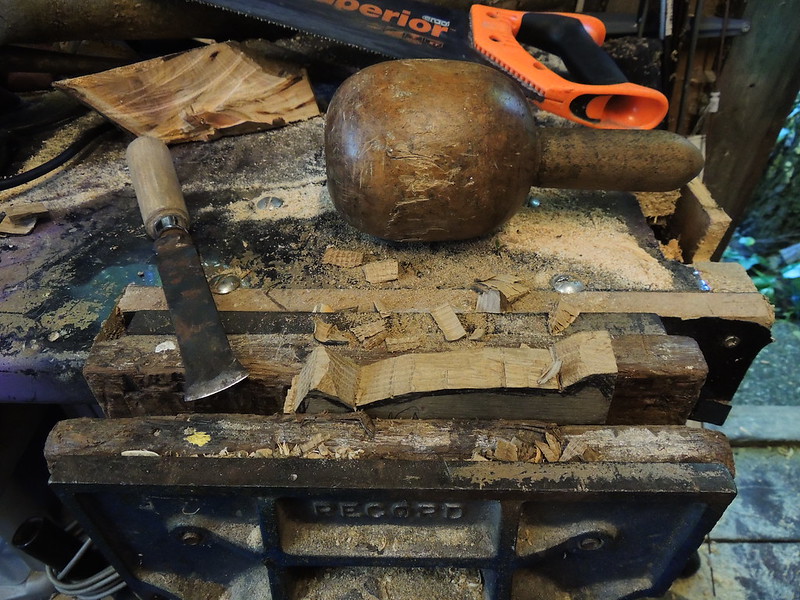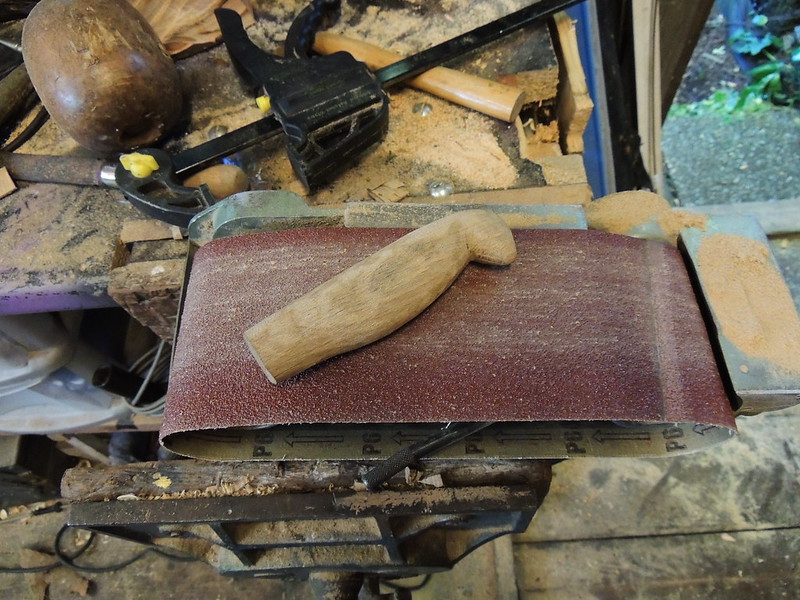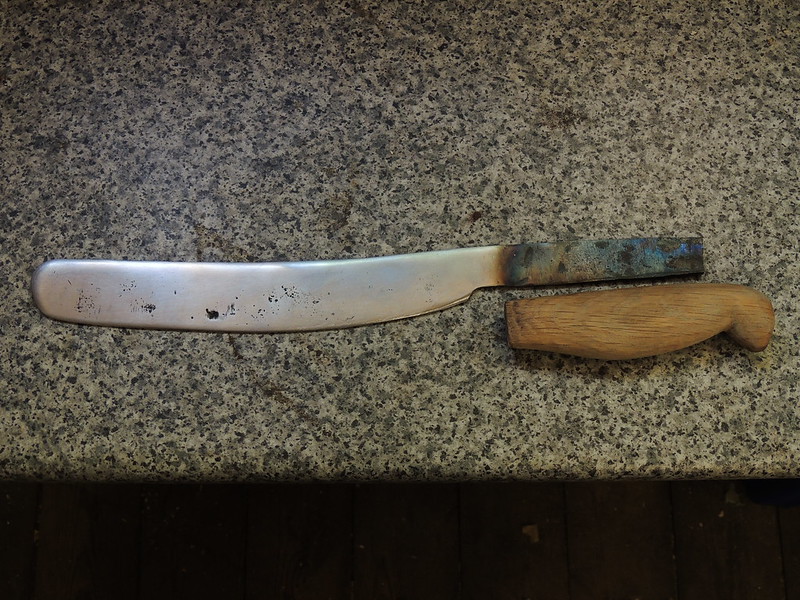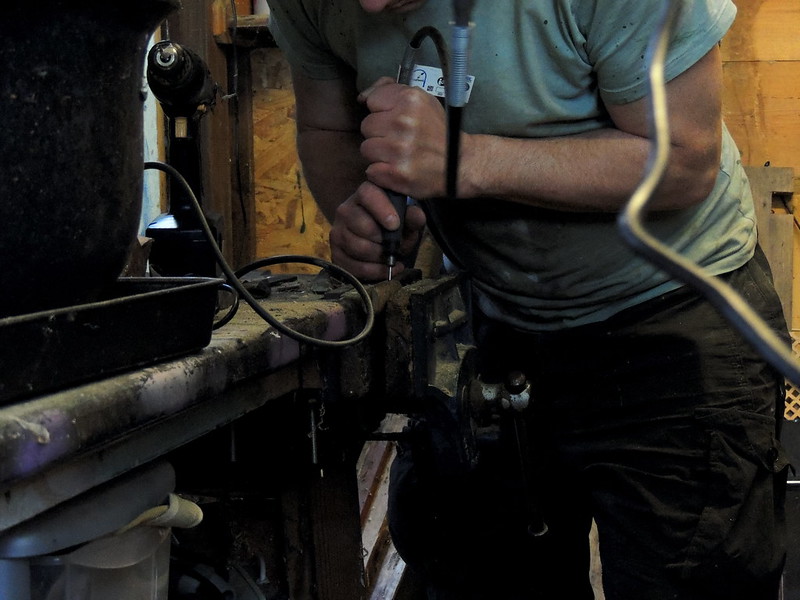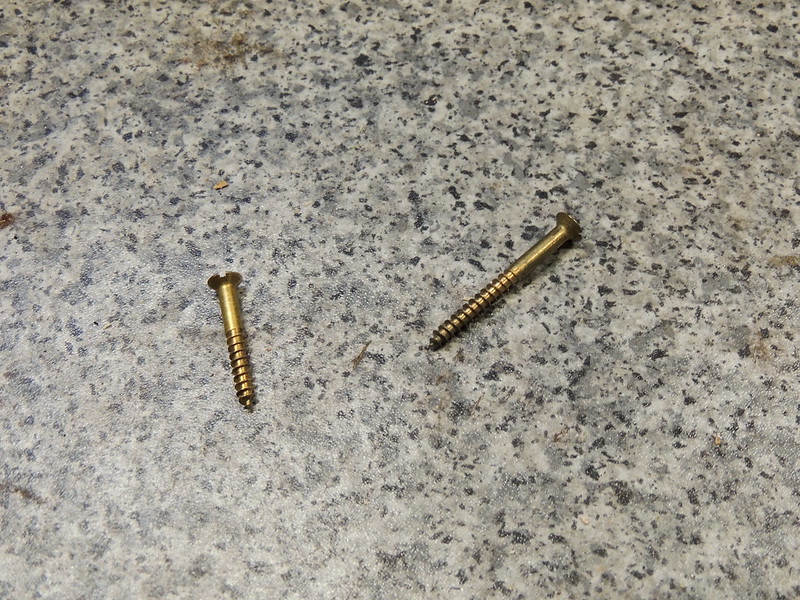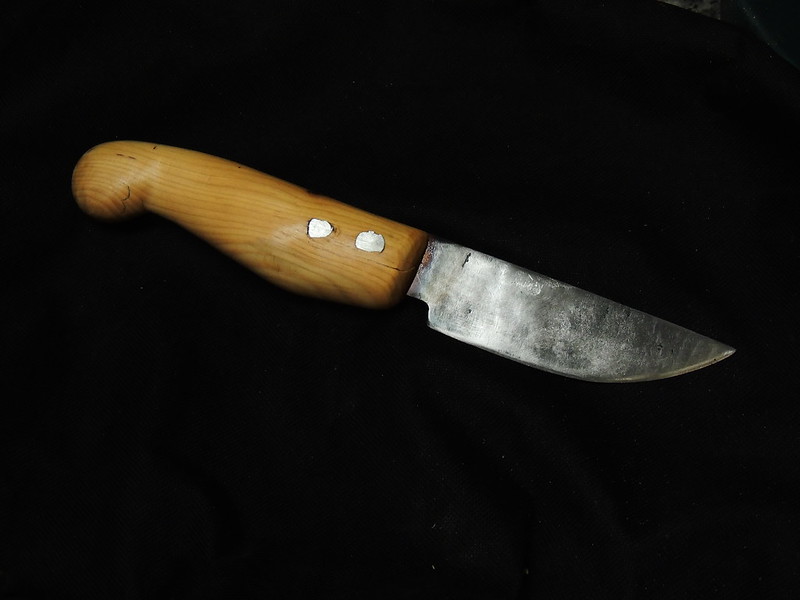I managed it just, with a lot of mulling over the lock ring. Rather pleased with this. Not perfect, but instantly loved the feel of it. Long may it slice ceps.
I also love that it looks about a century old already :)
Before: the crank axle is as it was discovered (as junk) in the spanner box where it had been for at least 20 years!
...until the pretty thick axle I started with, had been honed into a tapering flat.
Eventually it was forged into this. It doesn't look much here yet, but under that patina lies lovely high strength steel, probably with chrome, vanadium or tungsten in it. You can't see it, but it is beaten to a tapering edge from top to bottom...
And some use of the bench grinder. The angle grinder in the background was used earlier to cut out the rough blade shape before grinding.
after a bit of shaping, the blade shape started to become more obvious and to look much more like the design. You can see the sander belt grinding marks. At this stage, a very coarse grit was used to shape it roughly and quickly. It was a 60 grit belt.
After some care and taking the grit down to 80 the shape emerges. Here you can see marker pen lines used as sanding guides.
And taking the grit down to 120 until the basic shape is achieved. This shows plan view showing the shape of the blade, but the grinding is also refining and evening out the taper from the thicker back (aka spine) thinning down evenly to the cutting edge.
After this the polishing is done on a much subtler random orbit sander...
Before: here is a section of plank. You can see where bits have been sawn off for handles.
The handle pattern was traced over from the design sketch using the old classroom method of transferring by soaking the paper with repeated marker pen traces, then using a hard pencil to redraw the shape, which pushes the ink down onto the wood. So simple.
To get a rough, various stop cuts are made to prevent splitting too far along the grain.
...and then carving out the inner cuts doesn't slice off the handle lobes!
This chisel is not really intended for this. It is a double bevel carving chisel made from an old file, with experimental convex faced edge. It is best for making stop cuts into gouge-cut curved furrows, but was quite acceptable here.
Really though, I just wanted to make a tool using other tools I'd made.
The mallet is a development on the traditional truncated cone carving mallet. It is a wooden roller from an archaic lawnmower with a carved beech handle. You can strike cleanly from almost any angle - saves wrist strain when used over several hours.
Once the handle had been roughed out, it got shaped on the same belt sander used for the blade. This is much more of a 3d shape, so requires arching draws across the belt to get an even curve.
As the shape develops, it was kept to task by referring back to the design. Here it is pretty raw...
And after the basic shaping...
And so on...
And so on (the end for the hinge and lock ring is starting to show here)


The blade was put into position, then a hole carefull drilled through all three layers of wood/metal/wood.
This is the thing to spend some real care with. Break the wood and you'll need a new handle :(
Once the pivot hole was drilled, a pin was riveted in place to create the hinge. This was simply a brass wood screw, like these...
But, before the hinge is completed, the wood needed protecting with a ferrule. This is a metal collar that encloses the wood, preventing it moving under strain, which would otherwise allow it to crack. This is the same thing you get on chisel handles.
The ferrule was cut from this towel rail...
 It had a slot cut which was lined up with the underside of the hinge. The hinge was then closed by riveting it in with the screw acting as hinge pin. Brass is malleable so this is pretty easy. I don't have a picture here, but the rivet heads were also filed to consistent shapes. The normal cross-slotted screw head needed shaping down into a rounded head to match the hammered end
It had a slot cut which was lined up with the underside of the hinge. The hinge was then closed by riveting it in with the screw acting as hinge pin. Brass is malleable so this is pretty easy. I don't have a picture here, but the rivet heads were also filed to consistent shapes. The normal cross-slotted screw head needed shaping down into a rounded head to match the hammered end
The last piece of the mechanism was the enclosing lock ring. This required a ring with a groove in which the hinge pin heads could run (thus keeping it in place). This was a bugger. Various methods were attempted.
These included trying to rout a roove in a brass cylinder cut from a plumbing compression joint (the groove worked, but the brass was too brittle to clip on and broke trying - fail!). Next up was trying to do it by folding thin steel so that the folds created raised ends leaving a channel - sort of worked, but it couldn't keep the shape sufficiently to use
Here are some failures...
Eventually, this was achieved by bending a thicker piece of sheet steel cut from the foot plate of an Ikea bin. This is quite thick. The flat steel was cut to size, then folded over a nail in the vice, then worked back to form a flat plate with a groove in it. This took quite a lot of working with a hammer and cold chisel. It was then clamped over a pipe and hammered into the cylindrical shape needed. You can see the chisel marks at the edges of the raised groove.
et voila - not bad for 9 hours toil.
And here it is folded for carrying - light and small (about 4")
I love oak. So dense and rock hard, and takes a lovely, rich sheen with just oil (walnut oil here).
Design
After having a look at a standard Arpinel close-up, I had a thorough trawl through online and found lots of info. This page was great as it showed all the components laid out...
http://www.thetruthaboutknives.com/2013/11/knife-review-opinel-no-8-carbone/
Then I sketched out what the blade needed to look at 1:1 scale, cut out a plastic template and used that to show how it looked in various states of being folded. This allowed me to create this working drawing...
Drawing the end result helps visualise what you are working towards when carving, hammering, etc. Once it's in your mind, you can make it without the diagram largely. You just see the end result and work towards it.
Scavenging raw Materials...
Making a knife from scratch may be tricky, but finding the raw materials to make it from is not.
Blade - previously: an old bike crank axle
The first thing to get was raw steel for the blade. I wanted a stainless steel and one that was going to be reliably tough. Eventually I discovered this long abandoned bike crank axle. Axles need to be super strong in use and it seemed ideal.Before: the crank axle is as it was discovered (as junk) in the spanner box where it had been for at least 20 years!
This needed some serious heating on the DIY forge (that is the barbecue, pimped up with a fan-assisted bellows)...
Then some enthusiastic pounding on the anvil...
...until the pretty thick axle I started with, had been honed into a tapering flat.
Eventually it was forged into this. It doesn't look much here yet, but under that patina lies lovely high strength steel, probably with chrome, vanadium or tungsten in it. You can't see it, but it is beaten to a tapering edge from top to bottom...
It then needed cutting to get the right part out that was needed, so it could be ground more finely to shape.
Here is the raw hammered blade next to the working sketch. You can just make out where the blade will be cut from. This outline was drawn using the same template use to create the sketch.
Here's the piece after cutting out in rough, but before grinding.
At this point, raw hammered steel needs shaping on the belt sander... (this pic is actually a separate blade as I seem not to have taken a shot of this stage!!)
Here is the raw hammered blade next to the working sketch. You can just make out where the blade will be cut from. This outline was drawn using the same template use to create the sketch.
Here's the piece after cutting out in rough, but before grinding.
At this point, raw hammered steel needs shaping on the belt sander... (this pic is actually a separate blade as I seem not to have taken a shot of this stage!!)
And some use of the bench grinder. The angle grinder in the background was used earlier to cut out the rough blade shape before grinding.
after a bit of shaping, the blade shape started to become more obvious and to look much more like the design. You can see the sander belt grinding marks. At this stage, a very coarse grit was used to shape it roughly and quickly. It was a 60 grit belt.
After some care and taking the grit down to 80 the shape emerges. Here you can see marker pen lines used as sanding guides.
And taking the grit down to 120 until the basic shape is achieved. This shows plan view showing the shape of the blade, but the grinding is also refining and evening out the taper from the thicker back (aka spine) thinning down evenly to the cutting edge.
After this the polishing is done on a much subtler random orbit sander...
Handle - previously part of old oak floorboard
This wood is from a pile of disgarded old oak floorboards that I found in a skip a few years ago. A fabulous find. I've used the lovely seasoned hard oak from them, for loads of things since - boxes, handles and so on.Before: here is a section of plank. You can see where bits have been sawn off for handles.
The handle pattern was traced over from the design sketch using the old classroom method of transferring by soaking the paper with repeated marker pen traces, then using a hard pencil to redraw the shape, which pushes the ink down onto the wood. So simple.
To get a rough, various stop cuts are made to prevent splitting too far along the grain.
...and then carving out the inner cuts doesn't slice off the handle lobes!
This chisel is not really intended for this. It is a double bevel carving chisel made from an old file, with experimental convex faced edge. It is best for making stop cuts into gouge-cut curved furrows, but was quite acceptable here.
Really though, I just wanted to make a tool using other tools I'd made.
The mallet is a development on the traditional truncated cone carving mallet. It is a wooden roller from an archaic lawnmower with a carved beech handle. You can strike cleanly from almost any angle - saves wrist strain when used over several hours.
Once the handle had been roughed out, it got shaped on the same belt sander used for the blade. This is much more of a 3d shape, so requires arching draws across the belt to get an even curve.
As the shape develops, it was kept to task by referring back to the design. Here it is pretty raw...
And after the basic shaping...
And so on...
And so on (the end for the hinge and lock ring is starting to show here)
Hinge and locking ring - previously a wood screw, a section of towel rail and a piece of steel cut from a pedal bin


Once the handle and blade were cut and smoothed to close to final shape, the hinge and locking ring mechanism needed to be fitted, so that the final shape would take their extra girth into account.
The hinge itself was simply created by sawing a groove into the blade end of the handle (the ferrule end).
The blade was put into position, then a hole carefull drilled through all three layers of wood/metal/wood.
This is the thing to spend some real care with. Break the wood and you'll need a new handle :(
Once the pivot hole was drilled, a pin was riveted in place to create the hinge. This was simply a brass wood screw, like these...
But, before the hinge is completed, the wood needed protecting with a ferrule. This is a metal collar that encloses the wood, preventing it moving under strain, which would otherwise allow it to crack. This is the same thing you get on chisel handles.
The ferrule was cut from this towel rail...
 It had a slot cut which was lined up with the underside of the hinge. The hinge was then closed by riveting it in with the screw acting as hinge pin. Brass is malleable so this is pretty easy. I don't have a picture here, but the rivet heads were also filed to consistent shapes. The normal cross-slotted screw head needed shaping down into a rounded head to match the hammered end
It had a slot cut which was lined up with the underside of the hinge. The hinge was then closed by riveting it in with the screw acting as hinge pin. Brass is malleable so this is pretty easy. I don't have a picture here, but the rivet heads were also filed to consistent shapes. The normal cross-slotted screw head needed shaping down into a rounded head to match the hammered endThe last piece of the mechanism was the enclosing lock ring. This required a ring with a groove in which the hinge pin heads could run (thus keeping it in place). This was a bugger. Various methods were attempted.
These included trying to rout a roove in a brass cylinder cut from a plumbing compression joint (the groove worked, but the brass was too brittle to clip on and broke trying - fail!). Next up was trying to do it by folding thin steel so that the folds created raised ends leaving a channel - sort of worked, but it couldn't keep the shape sufficiently to use
Here are some failures...
Eventually, this was achieved by bending a thicker piece of sheet steel cut from the foot plate of an Ikea bin. This is quite thick. The flat steel was cut to size, then folded over a nail in the vice, then worked back to form a flat plate with a groove in it. This took quite a lot of working with a hammer and cold chisel. It was then clamped over a pipe and hammered into the cylindrical shape needed. You can see the chisel marks at the edges of the raised groove.






















